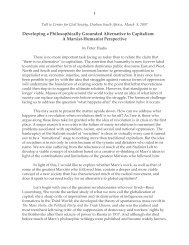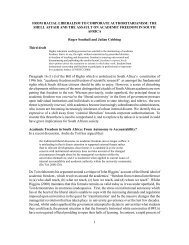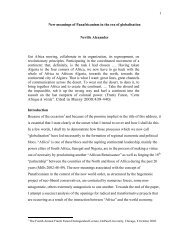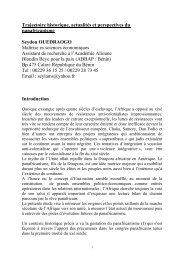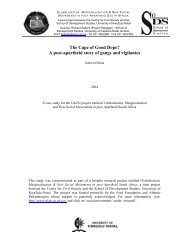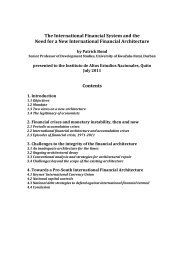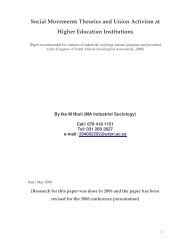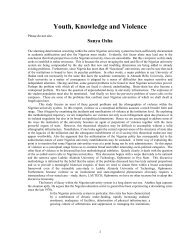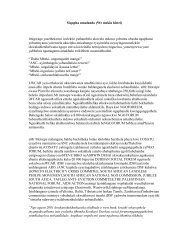April 2011 - Centre for Civil Society - University of KwaZulu-Natal
April 2011 - Centre for Civil Society - University of KwaZulu-Natal
April 2011 - Centre for Civil Society - University of KwaZulu-Natal
Create successful ePaper yourself
Turn your PDF publications into a flip-book with our unique Google optimized e-Paper software.
tanks’ that fill the media (many <strong>of</strong> which they own) with propaganda that<br />
glorifies the wealthy and demonises the poor, the working people, the<br />
public sector, taxation and government itself. They undermine democracy,<br />
funding politicians and then lobbying them to block re<strong>for</strong>ms <strong>of</strong> the<br />
financial system and regulations that might impede the growth <strong>of</strong> their<br />
wealth.<br />
In this gilded age, where so few own so much (and can avoid paying taxes<br />
by hiding their wealth in tax havens) and the rest suffer or are left to their<br />
own devices to merely survive, a new vocabulary – a glossary <strong>of</strong> greed – has<br />
developed around and <strong>for</strong> the super-rich. It speaks volumes about the new<br />
globalised order where disparity and extreme inequality reign supreme,<br />
just like the global over-class.<br />
OF HNWIS AND UHNWIS<br />
First, it’s important to know that there are <strong>of</strong>ficial terms <strong>for</strong> the very rich.<br />
They are known as ‘high net worth individuals’ or HNWIs. These are people<br />
who can, at the drop <strong>of</strong> a hat, put their hands on a million US dollars in<br />
‘liquid assets’,[10] also known as cash.<br />
The HNWIs’ numbers have started to grow again, following the global<br />
financial crisis <strong>of</strong> 2008, which a good number <strong>of</strong> them helped bring about<br />
with their reckless and woolly get-rich-on-bad-debt and derivatives<br />
schemes. In 2009, there were 95,000 HNWIs in the world (at least ones<br />
that we know <strong>of</strong> – many crime bosses, despots and dictators would<br />
certainly swell this number were their wealth not hidden <strong>of</strong>fshore).<br />
Between 2008 and 2009 their net worth rose 18.9 per cent – to $39<br />
trillion.[11]<br />
But all is relative when it comes to wealth. Just as the world’s majority –<br />
the average person in Africa, Latin America and Asia – can still be<br />
considered extremely poor (monetarily) next to the average person living<br />
in Europe or North America, so are the run-<strong>of</strong>-the-mill HNWIs relatively<br />
poor when compared with the UHNWIs. These are the ‘ultra high net worth<br />
individuals’, people who can produce $30 million cash at any moment.[12]<br />
UHNWIs have also seen their <strong>for</strong>tunes soar in the aftermath <strong>of</strong> the 2008<br />
financial crisis. In 2009, their wealth rose 21.9 per cent.[13]<br />
These days, however, given that 1,210 individuals now possess <strong>for</strong>tunes in<br />
the billions – far in excess <strong>of</strong> the lowly cut-<strong>of</strong>f point <strong>of</strong> $30 million <strong>for</strong><br />
UNHWIs – perhaps it’s time to come up with a new term to accommodate<br />
the swelling ranks <strong>of</strong> billionaires. Perhaps RAUHNWIs, ‘ridiculously,<br />
appallingly and unbelievably high net worth individuals’?<br />
THE COST OF LIVING EXTREMELY WELL<br />
Since 1976, Forbes has been providing a ‘CLEWI’ – Cost <strong>of</strong> Living Extremely<br />
Well Index’ – <strong>for</strong> the monetarily well endowed. Forbes earnestly explains<br />
that the CLEWI is ‘to the very rich what the Bureau <strong>of</strong> Labor Statistics’<br />
Consumer Price Index [CPI] is to ordinary people’. Between 2009 and 2010,<br />
the CLEWI showed a 1 per cent inflation rate on the HNWI basket <strong>of</strong> basics,<br />
while the CPI <strong>for</strong> ‘ordinary people’ rose 1.1 per cent.[14]<br />
But those things in an ordinary person’s basket – a cup <strong>of</strong> rice or grain<br />
perhaps and a couple <strong>of</strong> tablespoons <strong>of</strong> oil <strong>for</strong> the average West African, or<br />
a panoply <strong>of</strong> nutritious foodstuffs and other things average citizens in rich<br />
countries consider basics – are a far cry from what is to be found in the<br />
CLEWI baskets. Prices <strong>for</strong> some items have stayed steady: a suite at the<br />
New York Four Seasons ($4,650), a Rolls Royce Phantom ($380,000), a<br />
Hattaras 80 MY motor yacht ($5,281,600) and a facelift at the American<br />
Academy <strong>of</strong> Facial Plastic & Reconstructive Surgery (still just $17,000).



